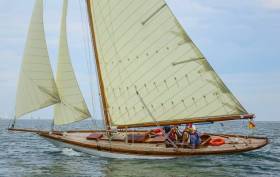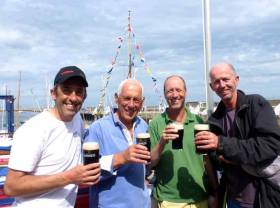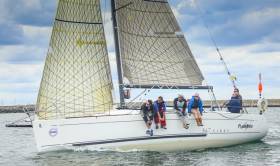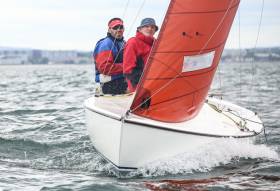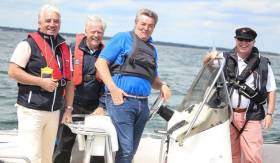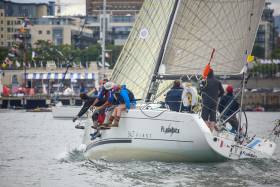Displaying items by tag: Dun Laoghaire Regatta
Entries Open for Volvo Dun Laoghaire Regatta: 2019's Big Sailing Event on Dublin Bay Will Have 39 Classes
As part of the 2019 announcement of next year's biggest sailing event in Ireland, next July's Volvo Dun Laoghaire Regatta will host a special event within the regatta for Scotland's RC35 yachts to compete for the 'Celtic Cup'.
Details of the Dublin Bay regatta have been published this week in the official Notice of Race that is downloadable below.
First thoughts, in an Irish context, of the RC35 concept were given by W M Nixon on Afloat.ie here.
The event is jointly organised by Dun Laoghaire's four waterfront clubs and will run from 11-14 July.
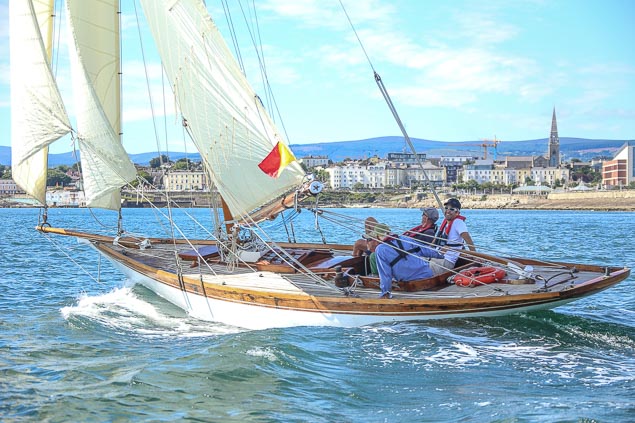 Classic yachts return to Dun Laoghaire for next July's Dun Laoghaire Regatta on Dublin Bay Photo: Afloat.ie
Classic yachts return to Dun Laoghaire for next July's Dun Laoghaire Regatta on Dublin Bay Photo: Afloat.ie
Feeder races for Dun Laoghaire's four-day regatta have been planned from Scotland, Northern Ireland, Wales and the west coast of England.
Event Chairman Don O'Dowd says 'we have a number of National and Regional events within the overall regatta which makes it more attractive for many to travel and compete'.
Entry is now open for 39 classes for racing, in Cruisers, One Designs, Dinghies and Classics.
Ireland's top Olympic, International & National Race Officers are in charge on the water and the organisers are forecasting a 480-boat fleet in total, drawn from 75 different Clubs from seven countries.
290 races are scheduled over four days.
 420s will race for National Championship honours as part of Volvo Dun Laoghaire Regatta Photo: Afloat.ie
420s will race for National Championship honours as part of Volvo Dun Laoghaire Regatta Photo: Afloat.ie
Super Early Bird Entry
A Super Early Bird Entry will run up to 31st December 2018. All fully paid entries will be automatically entered into a draw and 5% of those will be lucky enough to have their entry fee refunded.
Early Bird Entry will then remain open until 31st March 2019
Eight Championships Within Dun Laoghaire Regatta
The Regatta will incorporate the following Championships: -
- Royal Dee Yacht Club Irish Sea Offshore Championship
- RS Elite UK National Championship
- RC35 Class Celtic Cup
- Sigma 33 Irish National Championship
- GP14 Leinster Championship
- SB20 Westerns Championship
- Mermaid Leinster Championship
- 420 National Championship
Note: RC35 Class are not listed as a separate class. The Championship will run for them as a class within a class with separate results.
Download the 2019 Notice of Race below and see the online entry here
Dun Laoghaire Regatta’s Top Award Winner 'Myfanwy' Departs for Future Stardom in the Mediterranean
The memorable Dun Laoghaire Regatta of 2017 included celebrations for the Bicentenary of the great harbour, and the Kingstown 200 Trophy in its honour became something very special for racing among the Classics writes W M Nixon.
In a popular decision, the trophy was awarded to the beautifully-restored 1897-vintage 37ft cutter Myfanwy from Milford Haven in Wales. Thanks to a four-year re-building project by her veteran owner Rob Mason – a retired tugboat captain – Myfanwy had emerged from near-dereliction to become a vision of elegance that sails very well.
She is a classic yacht very much of the Irish Sea, originally built by Sam Bond at his renowned yard at Birkenhead on the River Mersey to the designs of Alexander Richardson (1845-1915) of Liverpool. For a couple of decades around the mid to late 1800s, Liverpool was one of the wealthiest cities in the world, and for a brief period it supported its own nationally-recognised yacht designer in Alexander Richardson, who is probably best known for his creation in 1884 of the all-conquering cutter Irex for Dublin whiskey magnate John Jameson.
Part of Myfanwy’s attraction is that Richardson seems to have been given a free hand in the project to create his own vision of what a perfect yacht should look like, for she is an almost-indulgent symphony of sweeping curves which are skillfully combined to provide a yacht of speed and style – arguably, she is his best-looking boat.
 Myfanwy’s crew in Dun Laoghaire Harbour are (left to right) Max Mason, Gus Stott, Andy Whitcher, and owner Rob Mason who restored the 1897 classic in a four year project. Photo: W M Nixon
Myfanwy’s crew in Dun Laoghaire Harbour are (left to right) Max Mason, Gus Stott, Andy Whitcher, and owner Rob Mason who restored the 1897 classic in a four year project. Photo: W M Nixon
In the days of her prime when based in the Menai Straits, she was unbeatable. Nevertheless when Rob Mason, his son Max, and shipmates Andy Whitcher and Gus Stott brought her over to Dun Laoghaire early in July last year to race in the Classics Division in VDLR 2017, she looked so interestingly beautiful that no-one would have minded too much if she’d only had an average performance by comparison with more modern classics. But she went like the wind, and at times was more than holding her own with the restored Dublin Bay 24 Periwinkle, a Bermudan-rigged design of 1938.
For Rob Mason, winning the Kingstown 200 trophy successfully rounded out his involvement with Myfanwy, for already he was thinking in terms of a more comfortable vintage motor-fishing yacht, and as mentioned in Afloat, he found exactly what he wanted with the 1938-built Blue Hills, which when new was originally based in Mulroy Bay in Donegal under the ownership of Frank Gilliland.
The acquisition of Blue Hills (now undergoing another of Rob Mason’s restorations) reinforced the decision to sell Myfanwy. But with such a unique boat, you need a new owner who will truly appreciates what he or she is getting. This has now happened, and any day now Myfanwy will be road-trailed to a specialist boatyard in Cornwall where she will be “purged” of standard modern fittings such as Tufnol blocks in order to comply with the requirements of CIM (Comite International de la Mediterranee).
Since 1926, CIM has been the final arbiter as to what constitutes an authentic classic yacht, and by the season of 2019, Myfanwy will be Mediterranean-based and racing to CIM rules. But for now, she leaves behind the fondest memories in Dublin Bay
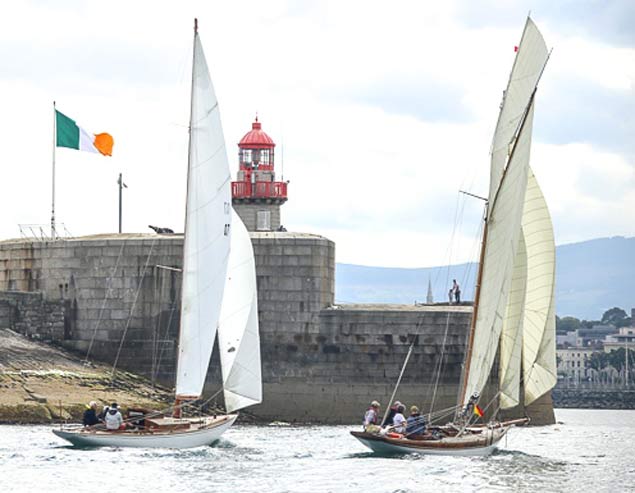 Memories of a great regatta. Perwinkle and Myfanwy neck-and-neck at the entrance to Dun Laoghaire Harbour during VDLR 2017. Photo: Afloat.ie/David O’Brien
Memories of a great regatta. Perwinkle and Myfanwy neck-and-neck at the entrance to Dun Laoghaire Harbour during VDLR 2017. Photo: Afloat.ie/David O’Brien
Dun Laoghaire Classics Champion Takes on New Restoration Challenge
Welsh skipper Rob Mason has taken on a new vintage boat restoration challenge writes W M Nixon. The retired Milford Haven tugboat skipper swept all before him when he brought his beautiful 1897-vintage 37ft restored cutter Myfanwy to the Volvo Dun Laoghaire Regatta 2017 in July last year. He and his cheerful crew went home with the Kingstown 200 Cup and a traditional purse of a hundred guineas, which they’d won in the classics racing to celebrate the Harbour Bicentenary.
 (Above and below) Classic winning elegance – Myfanwy on her way to taking the Kingstown 200 Cup last July. Photo David O’Brien/Afloat.ie
(Above and below) Classic winning elegance – Myfanwy on her way to taking the Kingstown 200 Cup last July. Photo David O’Brien/Afloat.ie
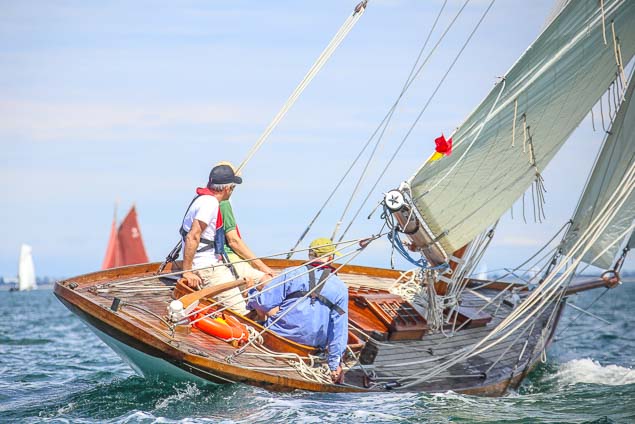
Myfanwy is now for sale and is attracting international interest, while Rob has found another project irresistible – the restoration of a 42ft 1938-built trawler yacht which he discovered in a very tired condition in the tidal port of Hayle in the far western corner of Cornwall.
He bought this boat Blue Hills knowing only the main aspects of her history, notably that she had been designed and well built by renowned fishing boat constructors W. Weatherhead of Cockenzie on Scotland’s East Coast, and that thanks to the installation of secret compartments in her comfortable accommodation, she’d had a successful World War II in 1939-1945 career smuggling secret agents across the North Sea.
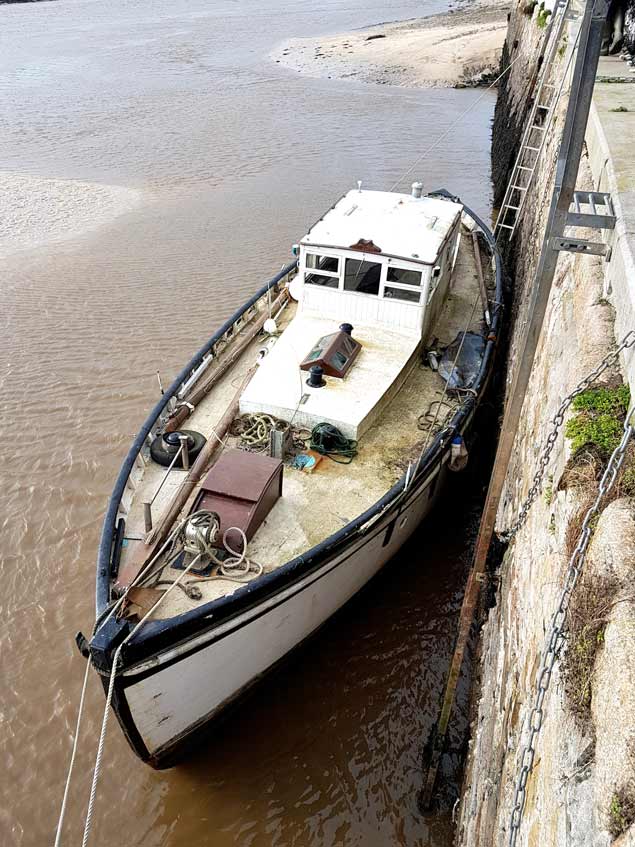 Blue Hills as she was when Rob Mason first saw her in Hayle in Cornwall. Photo: W M Nixon
Blue Hills as she was when Rob Mason first saw her in Hayle in Cornwall. Photo: W M Nixon
But now it has emerged that there’s an Irish twist to the tale, as Blue Hills was originally built to the very specific requirements of Frank Gilliland. He was a north coast cruising enthusiast (Donegal and cross channel ventures to the Hebrides were his speciality) who wanted to change to a seamanlike motor-cruiser after a long sailing career.
However, the brief period of cruising by Blue Hills from Lough Foyle and Donegal (where her moorings were in Mulroy Bay) was the only time she was in Ireland, for after her war service ended in 1945, she was sold to an owner in Devon. When Rob Mason found this attractive boat, she had been out of commission in Hayle for at least four years, but having seen what he could do with Myfanwy, the results with Blue Hills will be impressive.
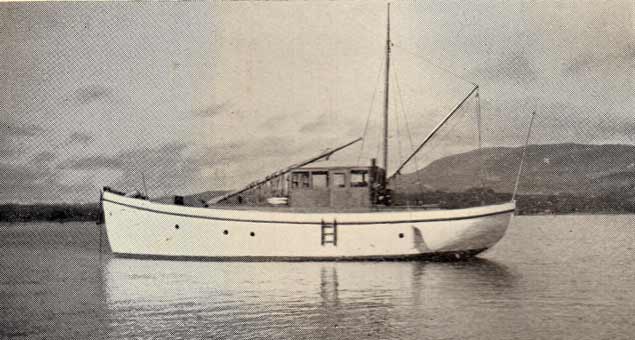 Blue Hills on her moorings in Donegal’s Mulroy Bay in 1938 while in Frank Gilliland’s original ownership.
Blue Hills on her moorings in Donegal’s Mulroy Bay in 1938 while in Frank Gilliland’s original ownership.
To do it, however, Blue Hills had to be moved to Rob’s hidden waterside home in the upper reaches of Milford Haven, and in order to do this she’d to be lifted out at Hayle (where the tides are large) and road-trailed the full length of Cornwall and Devon before traversing the entire width of South Wales to Pembroke for a further brief period afloat being towed in the shelter of Milford Haven to Rob’s place.
Fortunately the long road haul was done before the present bout of extreme bad weather interrupted, and Rob’s shipmate Andy Whitcher reports: “only three punctures, otherwise not a bother….” In other words, a formidable task, well done by people who knew what they were about.
 Blue Hills safely lifted at Hayle, but with the long road journey to southwest Wales still ahead of her. Photo: Andy Whitcher
Blue Hills safely lifted at Hayle, but with the long road journey to southwest Wales still ahead of her. Photo: Andy Whitcher
With the Donegal connection, we’ll he following this already fascinating story with extra interest. Meanwhile as they wait for the perfect tide to get Blue Hills into her proper restoration berth, Rob has been going through the many lockers, and reckons that some of them have never been fully emptied of assorted specialist spare parts in all the boat’s eighty years.
Dun Laoghaire Regatta was the Sailing Highlight of 2017
Here on Afloat.ie, in recent weeks we’ve carried several formalised reviews of the 2017 sailing season at home and abroad in its many aspects, and have looked forward to what 2018 may bring, and what it should bring. Yet as the year draws to a close, every Irish sailor will have his or her own special memories and impressions of a remarkably varied and active sailing programme, played out at many venues. W M Nixon gives us his 2017 stream of sailing consciousness from 2017.
“Well, we got a result….” There was a time - and it’s not so long ago – when that was reckoned a successful outcome for many sailing events in Ireland. And at a certain level, it still is. But in taking an impressionistic look back over the sailing of 2017, it’s clear that expectations have been rising all the time.
So much so, in fact, that just getting a result - even with the best of racing - no longer provides something which will lodge happily in the memory for a long time. There have to be several extra magic ingredients afloat and ashore. And in looking back over what’s best remembered from 2017, we are maybe stumbling on factors which will be the key to success in the major events of 2018 and beyond.
Obviously the central element in it all is the willingness for voluntary effort in the organising of events both large and small, afloat and ashore. Only the most major championship and regattas can expect to have a professional core – and even then, sometimes only one person – at the centre of things. The bulk of the work, both beforehand and once the event is running, has to be delegated, and it takes certain kinds of people with a very special voluntary attitudes to do it successfully.
 Serious racing. 420s in the Junior Pathway Nationals at Ballyholme on Belfast Lough in April, where more than 190 boats took part
Serious racing. 420s in the Junior Pathway Nationals at Ballyholme on Belfast Lough in April, where more than 190 boats took part
It’s not for everyone. Not everyone has the technical or social skills, and not everyone has the kind of personality for doing good work essentially by stealth. But when you do get a harmonious team of voluntary workers functioning productively to take best advantage of those happy times when ideal sailing conditions occur, then it’s a joy to behold.
Another factor is the strength of class associations. While huge world classes like the Lasers may have fully-manned international professional secretariats at their hearts, in Ireland in particular we cherish our numerous classes. And though some may be offshoots of an international design, it is the strength and energy of the Class Associations within Ireland which give them their special flavour.
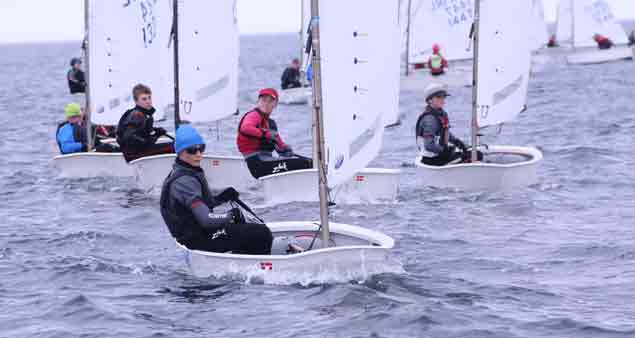 Irish sailing’s future. Optimists in strength at the Ballyholme Championship
Irish sailing’s future. Optimists in strength at the Ballyholme Championship
Some are so special they’re unique. We could devote several articles to the many activities and events of the International Optimist dinghy in Ireland, and likewise the International Topper. Yet we’d still barely be getting to grips with two remarkable sailing class structures, for their rapid throughput of rising junior talent always gives the picture the sense of a rapidly rolling tapestry.
 The International Topper made a significant contribution to the fleet size of 190 boats at Ballyholme.
The International Topper made a significant contribution to the fleet size of 190 boats at Ballyholme.
In a different area of the spectrum, the Irish GP 14 Association shows us what can be done by keen people with an adaptable vintage design, a truly nationwide community spirit, and a determination to get value for money. It’s a spirit which can be international, as we saw when the Worlds were staged at East Down YC on Strangford Lough in 2014. And it’s a spirit which can be deployed in the national interest as we saw in October 2017, when the class enthusiastically provided the fleet needed for the All-Ireland Helmsman’s Championship on Lough Owel at Mullingar.
Maintaining such a spirit needs a succession of keen key people, and we see it in classes of other types, sizes and locales. For instance, the Flying Fifteens in Dun Laoghaire with their can-do spirit are matched by the camaraderie-with-a-sense-of-history of their neighbours the Water Wags, while across Dublin Bay in Howth, the 1898-vintage Howth 17s are in better health than ever, with Ian Malcolm at the heart of a movement to keep this unique example of living history thriving.
 The GP 14s are a fine example of a vintage class which continues to thrive thanks to a very active class association.
The GP 14s are a fine example of a vintage class which continues to thrive thanks to a very active class association.
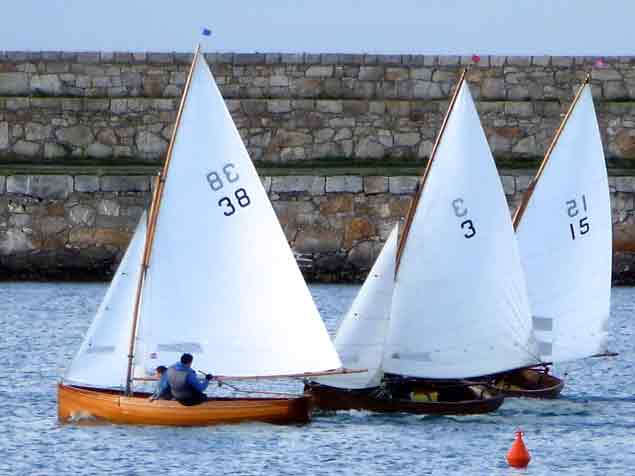 Despite being Centenarians for many years, the Water Wags thrived in 2017 as never before. Photo: W M Nixon
Despite being Centenarians for many years, the Water Wags thrived in 2017 as never before. Photo: W M Nixon
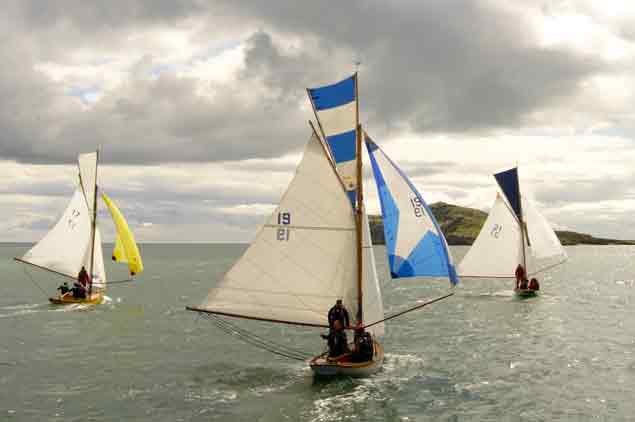 The 1898-vintage Howth 17s were in such good heart that in 2017 they even acquired a new-built boat, Orla (no 21) right. Photo: Neil Murphy
The 1898-vintage Howth 17s were in such good heart that in 2017 they even acquired a new-built boat, Orla (no 21) right. Photo: Neil Murphy
In newer classes, there’s evidence that the SB 20 is developing a fresh and healthy sense of being a special class which can do great things with the right spirit, and this is an attitude from which other more modern boat types can learn, for without people enthusiastically joined in a common purpose, they just become a collection of boats with nowhere to go.
Across country, the traditional boat movement in Galway – reflected in the continuing revival of the Achill Yawls in Clew Bay – provides its own special flavour, with the annual Galway gathering at Kinvara a mighty social event despite poor weather for August 2017’s staging.
 The Galway Hooker An Capall sailing in the waters of the west.
The Galway Hooker An Capall sailing in the waters of the west.
All of this will only impinge slightly on the south and southwest coasts, where boats and sailing are so much an integral part of the social structure that they’re a world to themselves, a self-sustaining universe which is now so large and varied that it’s wellnigh impossible to keep track of the way that our sport is developing.
Time was when you might find one or two boats secreted away on little-known anchorages on Cork Harbour. Most of the fleets would be concentrated at the main centres. But now, absolutely every cove has its little flotilla of boats, and you’d be hard put just to say how many boats are based within this wonderful natural sailing space.
And it’s not just a Cork Harbour phenomenon. Every inlet all round Ireland’s coast now has its local fleet. And every so often, events are staged which give us some notion of the numbers involved. And that also applies to the cruising brigade, whose doing are normally analysed from cruising log competitions during the winter.
For cruisers, 2017 brought an event which gave us some idea of the size and wide-ranging activity of the non-racing brethren. The fact that it wasn’t even staged in Ireland is further evidence of our new confidence and outward-looking approach. The Irish Cruising Club had been planning a rally in Galicia in northwest Spain for some years, the lead organiser being Peter Haden, whose home port is Ballyvaughan on Galway Bay, but he has wide-ranging experience and many contacts among the rias of Galicia.
 Michael Holland’s 70ft ketch Celtic Sprit in the Irish Cruising Club’s July rally to northwest Spain. Photo: Trish Phelan
Michael Holland’s 70ft ketch Celtic Sprit in the Irish Cruising Club’s July rally to northwest Spain. Photo: Trish Phelan
It was expected that if all went well, the rally in July 2017 might attract as many as 30 boats. In the end, they’d to cap numbers at sixty, and many of them had sailed from Ireland across the Bay of Biscay, some from the furthest ports in the north. It went superbly well, and gave tangible evidence of just how much Irish sailing has come on in the past twenty years.
At home on the offshore racing front, the single highlight was the Dun Laoghaire to Dingle Race – won in tough weather by Paul O’Higgins’ JPK 10.80 Rockabill VI – but a significant turnout in the Fastnet Race saw Michael Boyd’s Lisa be best of the Irish, right among the front runners, while the Irish National Sailing School’s J/109 Jedi won Class 3B and the Roger Justice Trophy for the best-placed school bat. Her crew included 17-year-old Lorcan Tighe, who was sailing as an instructor rather than a trainee, and already had the experience of the 2016 Round Ireland Race under his belt at the age of 16.
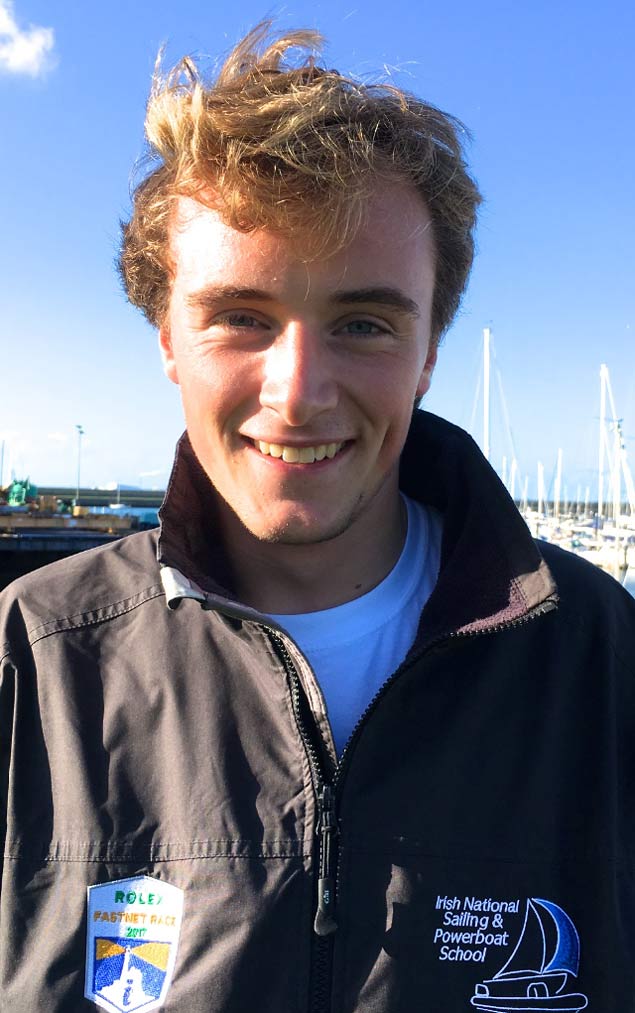 Lorcan Tighe of Dun Laoghaire, an offshore veteran at 17. He was an instructor aboard the Irish National Sailing School’s J/109 Jedi which won two prizes in the Rolex Fastnet Race 2017, and was foredeck hand aboard Lynx in the 2016 Volvo Round Ireland Race.
Lorcan Tighe of Dun Laoghaire, an offshore veteran at 17. He was an instructor aboard the Irish National Sailing School’s J/109 Jedi which won two prizes in the Rolex Fastnet Race 2017, and was foredeck hand aboard Lynx in the 2016 Volvo Round Ireland Race.
But while this high profile international success was important, a key aspect of Irish sailing in 2017 was the growing good health of the Irish Sea Offshore Racing Association, largely thanks to the untiring efforts of Chairman Peter Ryan of Dun Laoghaire, who is the very essence of the spirit of ready voluntarism and quiet persuasion which makes Irish sailing what it is today.
Something which became more clear during 2017 was the readiness of sailors to differentiate between class, regional, national and international championships as being on a different plane from regatta events. This differentiation can be fairly fluid. For instance, some dinghy classes make their racing in the Volvo Dun Laoghaire Regatta their Leinster Championship as well. But generally, there was no mistaking the difference between the serious mood of the ICRA Nationals at Crosshaven as against the Sovereigns Cup at Kinsale, or the huge-fleet Irish Sailing Junior Pathway Nationals at Balyholme in April when compared to the more relaxed Junior Regatta at Howth in August.
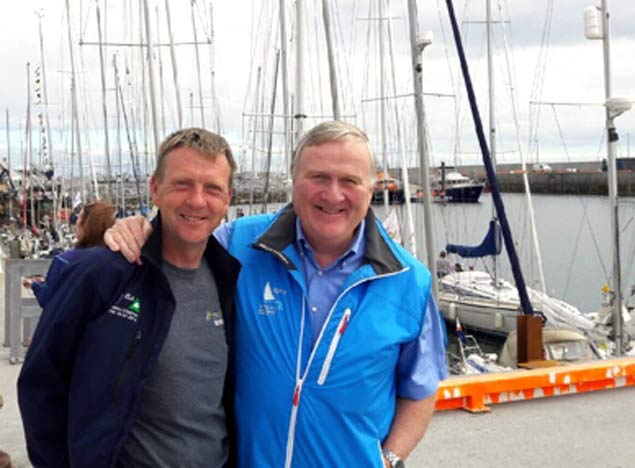 Simon McGibney (Commodore, Irish Cruiser-Racer Association) and Jack Roy, President Irish Sailing, in July at the first-ever WIORA Championship to be staged at Kilronan in the Aran Islands.
Simon McGibney (Commodore, Irish Cruiser-Racer Association) and Jack Roy, President Irish Sailing, in July at the first-ever WIORA Championship to be staged at Kilronan in the Aran Islands.
Of course, some events carved a character so individual as to defy classification, such as Calves Week in August at Schull, or the Half Ton Classics at Kinsale the same month, or the WIORA Championship in the Aran Islands in July. That was something else altogether. Who would have thought, even ten years ago, that the very first sailing event at the new pontoons in Kilronan in our quintessentially western Aran Islands would attract a crack fleet of 44 boats, though local pundits did successfully predict that Liam Burke with Tribal would be the winner.
These highly-populated and fun-oriented events contrast markedly with the world of the international single-handers, who may start from much-visited event villages at their departure ports, but they’re utterly on their own out at sea. Yet they keep at it, and Tom Dolan of Meath recorded Ireland’s best-ever place in the Mini-Transat with a sixth overall in a class of 54 boats in 2017’s staging of the little boats’ big crossing.
 Tom Dolan’s Pogo 3 IRL 910 in flying form.
Tom Dolan’s Pogo 3 IRL 910 in flying form.
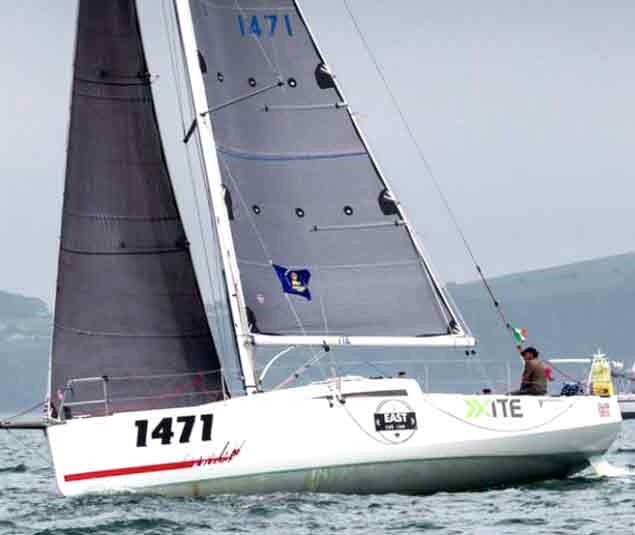 Conor Fogerty’s Sunfast 3600 Bam! at the start of the east-west Single-Handed Transatlantic Race, which was to experience a severe storm at mid-Atlantic, but the Irish boat went on to win the Gypsy Moth Trophy
Conor Fogerty’s Sunfast 3600 Bam! at the start of the east-west Single-Handed Transatlantic Race, which was to experience a severe storm at mid-Atlantic, but the Irish boat went on to win the Gypsy Moth Trophy
That was in November. But it was back at the end of May that the Single-Handed Transatlantic Race from Plymouth to Newport, Rhode Island got under way, with Conor Fogerty of Howth sailing for Ireland in his Sunfast 3600 Bam. The Atlantic in June was in a foul mood, and several boats were rescued, but Bam had gone so well she was to the westward of the very worst of the storm, and raced on the win the real prize, the Gypsy Moth Trophy.
The fact that he had done so had settled quietly into our memories of the early season until one morning at the end of November, when the bare hull of one of the abandoned Transatlantic single-handers, Michele Zambelli’s Illumina 12, was found upside down on a Kerry beach. It was a chilling relic of the mid-Atlantic super-storm of June, an eloquent reminder that Bam’s great victory was won against ferocious odds.
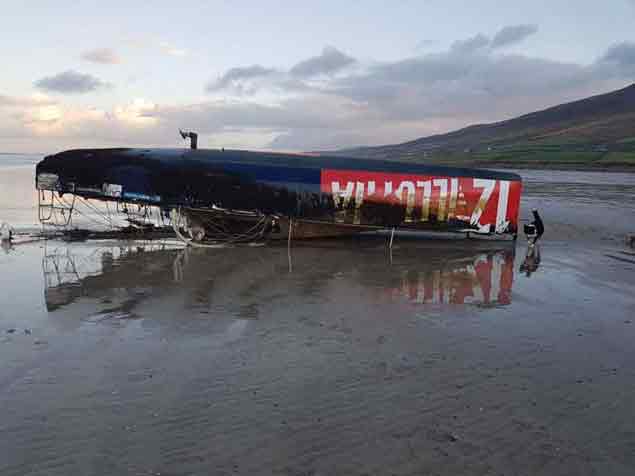 Chilling reminder of an Atlantic storm, The remains of the Italian Illuminia 12 on a Kerry beach a month ago.
Chilling reminder of an Atlantic storm, The remains of the Italian Illuminia 12 on a Kerry beach a month ago.
In the post-Olympic year, the Olympic contenders were going through a quiet phase, but they’ll getting up to speed again early in 2018, though Silver Medallist Annalise Murphy is on a different tack at the moment. She’s a crew-member on Turn the Tide on Plastic in the Volvo Ocean Race, but her Olympic preliminaries in 2018 have been factored in.
Meanwhile in 2017, when summer did finally come to Ireland in July, we had the event and the organization in place to do it full justice. The Volvo Dun Laoghaire Regatta 2017, from July 6th to 9th also celebrated the Bicentenary of Kingstown Harbour, and was simply the best sailing event in Ireland in Ireland during the year that is now leaving us.
 Celebrating 200 years. A perfect summer’s afternoon as the restored Dublin Bay Perwinkle and the restored 1897 cutter Myfanwy race for the Dun Laoghaire entrance and the in-harbour finish. Photo: Afloat.ie/David O’Brien
Celebrating 200 years. A perfect summer’s afternoon as the restored Dublin Bay Perwinkle and the restored 1897 cutter Myfanwy race for the Dun Laoghaire entrance and the in-harbour finish. Photo: Afloat.ie/David O’Brien
The experience and the organisation were in place under Chairman Tim Goodbody to do the occasion justice, the entry numbers were up with an impressive Classics and Traditional section to honour the Bicentenary. All that was needed was the weather, and the Irish climate obliged. There were sailing breezes every day, sunshine every day, and with it all a comfortably warm ambient temperature that kept up late into the night to facilitate an indoors/outdoors lifestyle that had Dun Laoghaire’s classically elegant waterfront heaving with celebrating people having the time of their lives.
That it seemed so good may have something to do with the fact that many 2017 sailing events in Ireland were unlucky with their weather. It was just the way things panned out. But Dun Laoghaire with its entertaining in-harbour finishes was pure regatta with prizes galore – so many, in fact, that we need remember only one to represent them all.
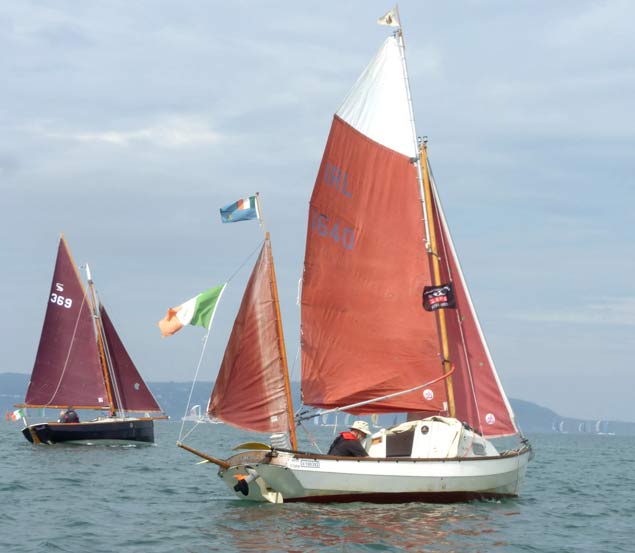 All were welcome to race in the Classics & Traditional section at the Kingstown Bicentenary. This is Jack O’Keeffe’s much-travelled Drascombe from Cork. Photo: W M Nixon
All were welcome to race in the Classics & Traditional section at the Kingstown Bicentenary. This is Jack O’Keeffe’s much-travelled Drascombe from Cork. Photo: W M Nixon
But it was the special one. The Kingstown 200 cup complete with a traditional purse of 100 guineas. And it went to a very special visitor, the 1897-built 37ft Myfanwy from Wales, originally designed by the great Alexander Richardson of Liverpool (he designed John Jameson’s all-conquering Irex), and restored by her owner-skipper Rob Mason of Milford Haven.
With her sweeping sheer and classic jackyard topsail-setting rig, Myfanwy was arguably the best-looking boat in the regatta. And when I was chatting with her convivial crew after the last race, they were in great form – they downed their pints of Guinness, and asserted that they’d just enjoyed the best five days of sailing in their lives. And that was before they were told that they’d won the Kingstown Cup, purse and all……
 Purest classics. Hal Sisk’s Peggy Bawn (1894, left) and Rob Mason’s 1897 Myfanwy in Dun Laoghaire. Peggy Bawn was fulfilling the classic spirit so completely that she was setting a suit of unused cotton sails at least sixty years old. Photo: W M Nixon
Purest classics. Hal Sisk’s Peggy Bawn (1894, left) and Rob Mason’s 1897 Myfanwy in Dun Laoghaire. Peggy Bawn was fulfilling the classic spirit so completely that she was setting a suit of unused cotton sails at least sixty years old. Photo: W M Nixon
Until a couple of days ago, it was planned to end this last blog of 2017 on that friendly note. For we can all learn much from the success of the Volvo Dun Laoghaire Regatta 2017 and its Kingstown Harbour Bicentenary. It was the perfect combination of good but not too serious racing afloat, and brilliantly done fun times ashore.
But then with the end of 2017 in sight, along comes the Rolex Sydney-Hobart Race 2017, extremely serious stuff. After various kerfuffles, Jim Cooney, whose people hail from Ballivor in County Meath, has taken line honours with the 100ft LDV Comanche, while Gordon Maguire of Howth has mastered the TP 52 Ichi Ban (Matt Allen) into a very hard-fought overall win. Words fail us. But then we recall that after Michael Boyd won the 1996 Round Ireland with the J/35 Big Ears, the incomparable Meath Chronicle ran the splendid headline: “Lobinstown Man Wins Round Ireland Yacht Race”. We live in hope of a similar headline: “Ballivor Man Leads Top Australian Yacht Race.”
And a happy and prosperous New Year to you too.
Taking on the dominance of the Dun Laoghaire J109 offshore fleet on its home waters and winning is no mean feat. Winning skipper Paddy Gregory of the Beneteau First 34.7 Flashback (owned by Don Breen and David Hogg) recalls last week's victory in Dun Laoghaire Regatta's biggest class, the 31–boat offshore division and believes 'attention to detail' and a strong desire to win got the Howth Yacht Club crew over the line first.
We’ve all heard the term, “That’s Yacht Racing”. It’s a sport where the factors out of your control such as the weather, shifts, Gods, planets, rabbit-feet etc must all align to yield a result. All we can ever do is try and do the best with what we can control and go for it.
If I was to sum up this year’s event in a word I would say, ”tough”.
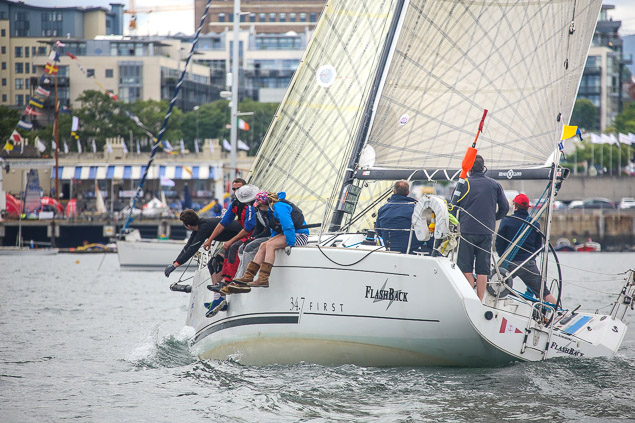 Yards from the harbour finish line and overall 2017 VDLR offshore class victory – Flashback's crew give it all they've got. Flashback were also crowned Offshore Champions in the RDYC Jack Ryan Championship as part of VDLR Photo: Afloat.ie
Yards from the harbour finish line and overall 2017 VDLR offshore class victory – Flashback's crew give it all they've got. Flashback were also crowned Offshore Champions in the RDYC Jack Ryan Championship as part of VDLR Photo: Afloat.ie
The usual vagaries of Dublin Bay did not disappoint and dished up the expected amount of tidal and wind challenges; in fairness we did get a little more wind than was forecast.
Although extremely frustrating at times the light airs benefited us against the bigger boats. In the last Dunlaoghaire week it was averaging 20knts and we worked extremely hard to place fourth overall in the Coastal fleet.
Flashback began racing in the ISORA Coastal series a few years ago and we haven’t looked back. The growth in the Coastal Class is a credit to Peter Ryan and his team at ISORA, as it goes from strength to strength, evidenced by it now being the biggest fleet at the VDLR 2017.
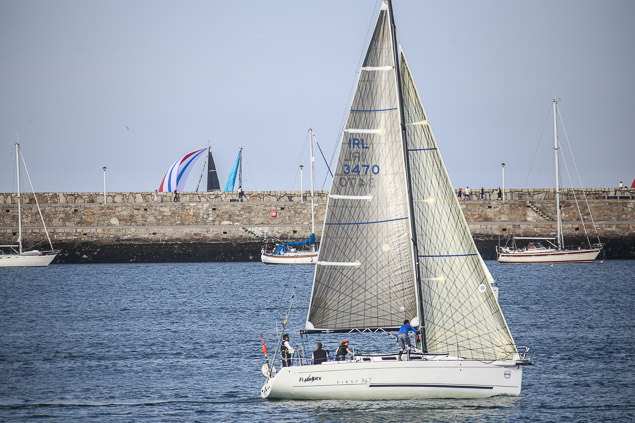 Flashback coming into finish during the first offshore race of Dun Laoghaire Regatta. Photo: Afloat.ie
Flashback coming into finish during the first offshore race of Dun Laoghaire Regatta. Photo: Afloat.ie
Flashback’s a standard Bruce Farr designed Beneteau First 34.7’ (overall length 32.7’!) that we commissioned in 2006 and we were lucky enough to win our first regatta in Dunlaoghaire that season. In the intervening years we’ve changed her very little, so we’re still using a 100m2 asymmetric spinnaker. We resisted the temptation to buy a larger rudder, which many of our sister-ships have done to help with control, choosing instead to learn how to cope with her eccentricities off the wind in a blow…….plus we saved some money!
About four seasons ago, having seen the trend on winning IRC boats, we decided to try non-overlapping headsails, instead of the 142% overlapping genoas that she was designed with, and it’s fair to say that our sailmaker Philip Watson (who we’ve worked very closely with over the twelve years ) really “nailed” it on his second attempt, and we now feel that she’s a faster boat for her rating than she’s ever been (moving from old rating 1003 to 986).
 Flashback's winning crew – Photo: Gareth Craig
Flashback's winning crew – Photo: Gareth Craig
We’ve been fortunate to have continuity of crew (panel of 15) and we now sail both of the Howth Yacht Club Winter series’ which keeps us relatively sharp when the Spring/Summer returns.
We’re very particular about having her underwater surfaces very clean because we don’t want to have that as an “ excuses to lose”. And we’re also picky about excess weight, so we strip off our cruising gear, such as sprayhood and TV, and keep her water & diesel tanks light before racing in events.
As a testament we moved from fourth in the 2015 event to first in 2017. 2015 was a heavy weather event and we all know what 2017 weather was like!
Flashback's crew were:
Paddy Gregory (Helm)
Don Breen Main (Trim)
Saraha Watson (Box)
Eamonn Burke (Kite trim and back up Bow/Mast)
Dave McGinn (Bow/Mast)
Des Flood (Head sail Trim)
Garath May (Head sail Trim)
Tactics (normally by general consensus!)
Bookies Get it Wrong As UK Visitors Win GP14 Leinster Championship at Dun Laoghaire Regatta
The GP14 fleet returned to Dun Laoghaire for a most enjoyable three day Leinster Championship at the 475–boat Volvo Dun Laoghaire Regatta where 27 GP14s competed, for the various honours over the full complement of 8 races. With both World Champion, Shane McCarthy, and Olympian, Ger Owens entered, there was much discussion as to who would win out. However the bookies would have had a field day as the championship was won in a most emphatic fashion, by visiting UK sailors Fergus Burnham and Andy Hunter from Snettisham Beach and Nantwich sailing clubs.
All was not as it appeared however, as Ger Owens took the unusual role of crewing for his good friend and former Olympic crew Ross Killian.
Friday saw the fleet on the South Bull race course with Barnham/Hunter laying down an early marker in Race 1, by pulling away to establish an early lead with Keith Louden and crew Alan Thompson signalling their intent by notching a definite second. Norman Lee showed a good turn of speed to sail into third place. Silver fleet sailor, young Peter Boyle crewed by his dad Stephen sailed a great race to slot into fifth place.
Race 2 threw up a great surprise with the first four rounding the weather mark heading off for the outer loop not realising that the inner loop was the correct course. Not quite believing what was unfolding in from of him, and ready to take full advantage ,was Hugh Gill and Conor Twohig who promptly led the rest of the fleet back down the run on the inner loop and went on to take the gun, followed home by the up and coming young guns of Sutton Dinghy Club, Alan Blay & David Johnston in second place, with Louden & Thompson taking third. This left the favourites slightly embarrassed and determined to do better. The final race of the day finally saw Shane McCarthy & Damien Bracken unleash their potential, and left the fleet looking at their transom as they took the bullet with Blay & Johnston showing early consistency by again taking second, and Barham & Hunter not letting go by taking third. Beer, food, sunshine and happy sailors on the deck at the Royal St George YC afterwards, lent a very Mediterranean atmosphere to the entire weekend!
Saturday ‘s forecast was for very light breezes but a good steady breeze blew all day long, providing great racing for the fleet. The highlight of the day was the three wins recorded by UK pairing of Barnham and Hunter, firmly establishing them in an unassailable position after 6 races. Gill and Louden took a second each with Lawrence Baalham and Robbie Richardson surprising all, by rounding the weather mark in fourth place and finishing the race in second place. The lads are still smiling! Blay & Johnson maintained their pace by notching a 4th and 3rd leaving them in second place with 2 races to go followed by McCarthy and Bracken in 3rd with Gill & Twohig in 4th overnight and all to play for.
In the Silver Fleet, the Boyles held a commanding lead on Saturday evening in front of the Gallagher brothers from Lough Foyle and Doire Shiels and Graham Burns from Skerries.
There was a great battle going on in the Bronze fleet with only 4 points separating the three contenders: Mathew Street from Blessington, Jack Buttimer from Youghal and Martin & Vicki Dews from Donaghadee in that order.
The fleet moved to the Salthill course on Sunday, and were treated to the close up sight of the Moth dinghies up on their foils and racing at incredible speeds in comparison to the comparably rather sedate speed of the regular classes. Quite spectacular! Well, the boys from the UK decided to do a bit of sightseeing around the bay and cruised to a leisurely 4th & 6th in the 2 races which they proceeded to discard, becoming worthy Leinster Championship winners. Keith Louden and Alan Thompson clocked in a very smart 1st & 5th to jump from 5th overall to 2nd overall – a great performance with Gill & Twohig surprising themselves to finish third in the Championship with a 6th & 3rd.
Consistent performer of the day was surely Curly Morris and Laura McFarlane who racked up a 3rd and 2nd.
In the Silver Fleet, Sunday saw Peter & Stephen score steadily. But in the last race Gareth & Richard Gallagher threw caution to the wind, started at the pin and steadily drew away to a convincing win which lays down a marker for the future. These are boys to watch when they get the consistency sorted.
Martin & Vicki Dews took a closely fought Bronze fleet by taking a 13th in the last race which saw them win by a mere 2 points from Mathew Street who was on equal points with Jack Buttimer.
Peter Boyle continues to show promise among the youngsters in the fleet and in finishing 7th overall was the leading Youth sailor and so is the new GP 14 Leinster Youth Champion for 2017.
A great Championship sailed in great conditions by a great fleet of sailors and friends. Long may it continue.
Gold Fleet:
1. Fergus Barnham & Andy Hunter - Snettisham Beach and Nantwich Sailing Clubs
2. Keith Louden & Alan Thompson – The Irish Sailing Association
3. Hugh Gill & Conor Twohig – Sutton Dinghy Club
Silver Fleet:
1. Peter & Stephen Boyle – Sutton Dinghy Club
2. Gareth & Richard Gallagher – Lough Foyle Yacht Club
3. Doire Shiels & Graham Burns – Skerries Sailing Club
Bronze Fleet:
1. Martin & Vicki Dews – Donaghadee Sailing Club
2. Mathew Street & Rionn O’Hailaigh– Blessington Sailing Club
3. Jack Buttimer & Adam McDonagh – Youghal Sailing Club
Full results here
Squibs Topped By Periquin At Dun Laoghaire Regatta
Dun Laoghaire regatta was the highlight of the celebrations of the 200th anniversary of the laying of the foundation stone for the great harbour of refuge in Kingstown in 1817. The regatta involved 475 boats in 35 classes including the Squibs. The Squib races for The Irish East Coast Championship were held in two locations in Dublin Bay- at Seapoint and at South Bull. The winds were generally less than 10knots for the entire four-day event.
Race one on Thursday afternoon was a runaway success for Sheila Power and Gillian Fletcher in Little Demon in what was their first outing of the year. Race two was won by Noel Colclough and Vincent Delany in Periquin. After sailing the party began in the Royal St George Yacht Club. On Friday, Periquin had her best day with three first places, including one race where she finished almost a leg ahead of the opposition. Anything Periquin could do could be equalled by Peter Wallace in Toy for the Boys on Saturday. However, a post-race protest resulted in Toys being disqualified under RRS 14.
Thus, after three days racing, it was clear which two Squibs were battling for supremacy. On Sunday morning race nine was won by Slipstream, following a great four way battle between Denis Todd’s Contender, Periquin, and Little Demon. The final race and tenth race of the series was won in convincing style by Toys, but she had not done enough to dislodge Periquin at the top of the leaderboard.
Tim Goodbody’s chairmanship of the Volvo Dun Laoghaire Regatta came to an end as the curtain fell on today's 2017 edition. Tim has held this role for the past two events and he hands over to incoming Chair, Don O’Dowd, at a particularly high point in the history of this great event, the third largest regatta in Europe, and an all amateur event.
Don follows a long line of distinguished former regatta chairmen including Brian Craig (2005 and 2007), Phil Smith (2009) and Adam WInklemann (2011 and 2013).
The Board of Dublin Bay Regattas Ltd, with Commodores of the Dun Laoghaire waterfront Yacht Cubs would like to acknowledge the massive contribution of Tim Goodbody in his role of chairman and thank him for all his involvement in the organisation of two 'incredibly successful' regattas.
Howth's 'Flashback' Moves Into Offshore Contention at Dun Laoghaire Regatta, Final Races on Sunday Morning
A sea breeze brought changes to the leader board in several classes in the penultimate day of Ireland's biggest sailing regatta, the Volvo Dun Laoghaire Regatta on Dublin Bay today.
One contender for tomorrow's (Sunday) top prize of the 'Volvo Boat of the Regatta Trophy' is a Howth Yacht Club yacht that took the lead in the biggest class this afternoon. Paddy Gregory's Flashback now tops the IRC offshore division after three coastal races sailed.
A promising eight to 10 knot south–easterly wind got racing for all 475 boats in 35 classes off to a solid start this morning and it held all day to keep the ambitious programme of more than 290 races on target for tomorrow's final round two rounds in most classes.
The Gregory led 31-boat IRC offshore fleet departed Scotsman's Bay bound for North Burford, the turning mark on the 20–mile course.
The north Dublin Beneteau 34.7 is six points clear overall of Chris Power–Smith's much J122 Aurelia in the 31–boat fleet even though Power–Smith was the winner of this afternoon's race.
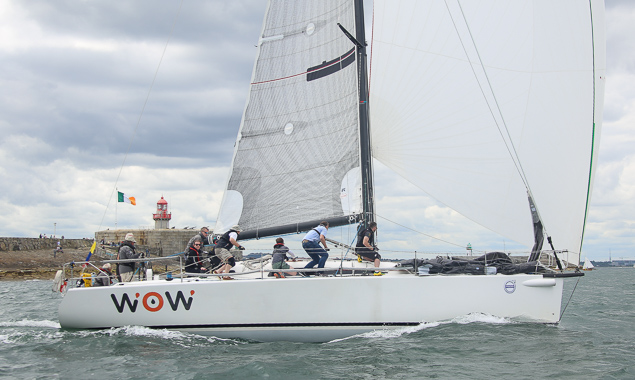 2015 VDLR Champion WOW (George Sisk) heads for the offshore class in–harbour finish line...
2015 VDLR Champion WOW (George Sisk) heads for the offshore class in–harbour finish line...
 ...followed on the water by Chris Power Smith's Aurelia, the IRC rating winner
...followed on the water by Chris Power Smith's Aurelia, the IRC rating winner
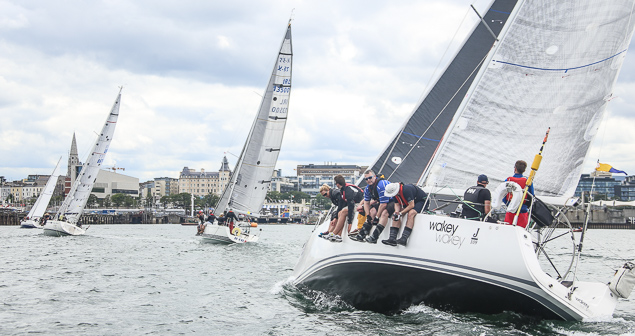 After a 20–mile race, the offshore fleet were tightly bunched as they headed for the finish line at the Royal St. George Yacht Club
After a 20–mile race, the offshore fleet were tightly bunched as they headed for the finish line at the Royal St. George Yacht Club
A single race tomorrow morning will decide the offshore title and also the Jack Ryan Whiskey Royal Dee Irish Sea Offshore Championship that is being sailed as part of the Dun Laoghaire Championships.
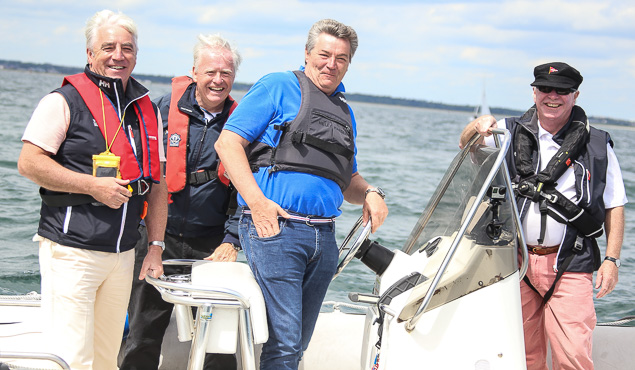 Dun Laoghaire Commodores afloat: Regatta vice chairman Don O'Dowd (third from left) with (from left) Commodores Paul Sherry of the Royal Irish Yacht Club, Ronan Beirne of the National Yacht Club and Michael Pomeroy of the Royal St. George Yacht Club carry out a check of all six race courses
Dun Laoghaire Commodores afloat: Regatta vice chairman Don O'Dowd (third from left) with (from left) Commodores Paul Sherry of the Royal Irish Yacht Club, Ronan Beirne of the National Yacht Club and Michael Pomeroy of the Royal St. George Yacht Club carry out a check of all six race courses
On the centre course, Classes Zero, One and Two completed three further races over windward–leeward courses under Race Officer Peter Crowley.
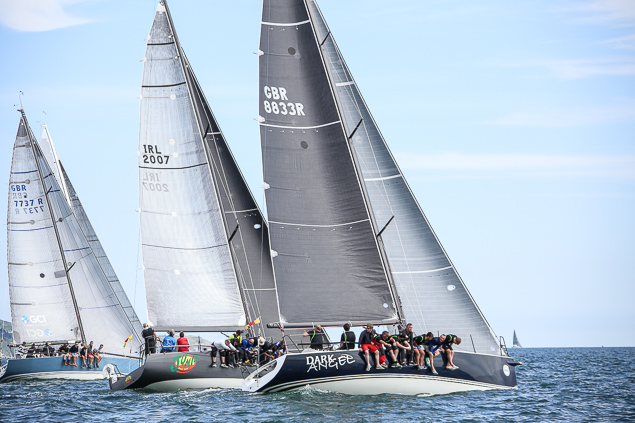 Dark Angel was fast off the line this morning in Class Zero
Dark Angel was fast off the line this morning in Class Zero
Jay Colville's Forty Licks from East Down Yacht Club has moved into the overall lead of the five–boat Class Zero fleet even though she shares the same eight points as one–time leader Dark Angel (Tony Ackland) from Swansea.
Royal Irish Yacht Club yachts top the leaderboard in 29–boat Class One with John Maybury's J109 Joker II – another top contender for yacht of the regatta – still leading but on a reduced margin of just three points after Richard Goodbody's J109 White Mischief had a stand–out performance to count a 1,2 and 3 today. Goodbody now moves up to second overall on 12 points. J109s complete the podium places with Ronan Harris's Jigarmee 21 points off the lead.
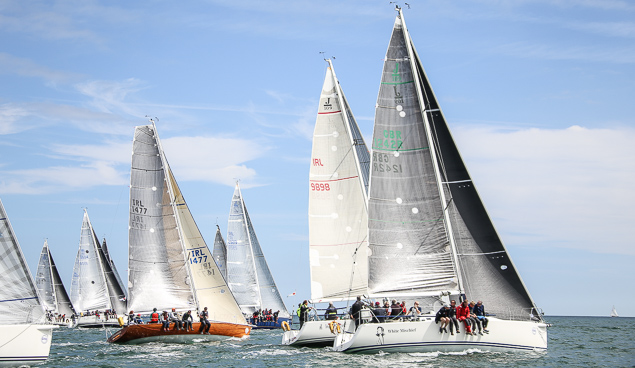 From this committee boat end start, Royal Irish J109 White Mischief (1245, skippered by Richard Goodbody) took the lead (below) in the 29–boat class one to win race one yesterday morning. The Dublin Bay entry also counted a 2 and a 3 today and is three points off the overall lead held by club mate John Maybury, Joker II. The stage is set for a thrilling conclusion in the final two races on Sunday
From this committee boat end start, Royal Irish J109 White Mischief (1245, skippered by Richard Goodbody) took the lead (below) in the 29–boat class one to win race one yesterday morning. The Dublin Bay entry also counted a 2 and a 3 today and is three points off the overall lead held by club mate John Maybury, Joker II. The stage is set for a thrilling conclusion in the final two races on Sunday
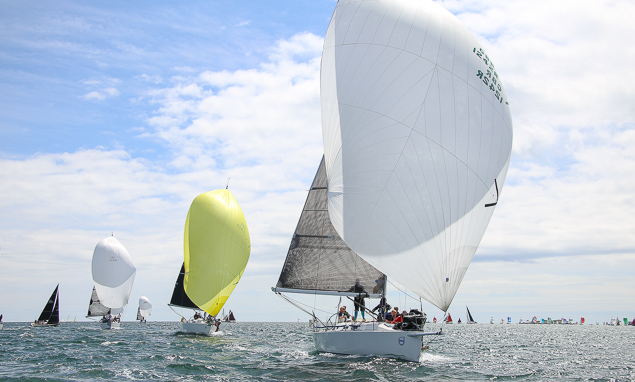
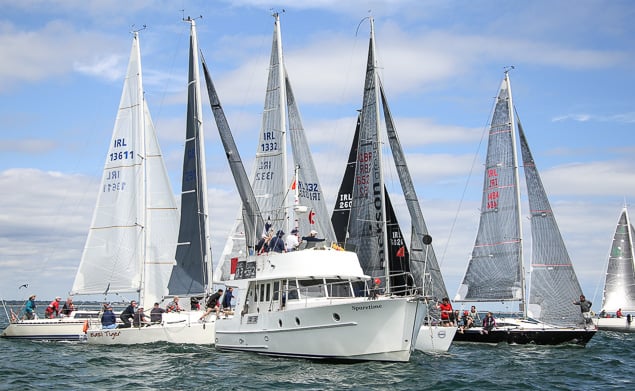 A crowded committee boat end in this morning's first race of class two eventually got clean away (below)
A crowded committee boat end in this morning's first race of class two eventually got clean away (below)

In the 17–boat Class two, Howth Yacht Club's Dave Cullen sailing the modified Half–tonner Checkmate has overtaken visiting Scottish Half–Tonner Trastada (skippered by Angus Roddy). Cullen who has six results in the top five and counted two race wins today for an eight point margin over the Clyde vintage yacht that dropped to as low as eighth in this afternoon's race six. In what is looking ery much like a battle of the Half tonners overall, the 2015 Volvo Regatta Class Two Champion Jonny Swan in Harmony is third.
 In spite of some good starts, Scotland's Trastada (GBR 6521) lost the overall class two lead today after three windward-leeward races
In spite of some good starts, Scotland's Trastada (GBR 6521) lost the overall class two lead today after three windward-leeward races
There is no change at the top of IRC three where another Howth Yacht, Richard Colwell's Fusion continues to dominate with four race wins from seven starts in the eight boat fleet. Howth Yacht Club boats occupy the top four spots with X302s Dux (Anthony Gore–Grimes) and Maximus (Paddy Kyne) second and third respectively.
In IRC four, Jonathan Flood's Modified Formula 28 Flash from Wicklow Sailing Club leads Cartoon (Ken Lawless) by a point and half after eight races sailed in the 15–boat fleet.
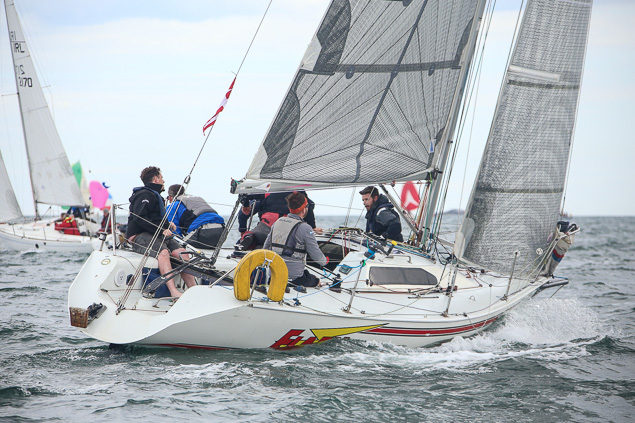 Jonathan Flood's Modified Formula 28 leads in Class Four
Jonathan Flood's Modified Formula 28 leads in Class Four
 Ken Lawless's Cartoon is second overall in Class Four
Ken Lawless's Cartoon is second overall in Class Four
 2015 Class four VDLR champion Cri Cri (Paul Colton)
2015 Class four VDLR champion Cri Cri (Paul Colton)
In the one design classes, only half a point after eight races separates St Spence's Clyde based Carna and Andrew Bradley's Chinook from the Royal Irish Yacht Club.
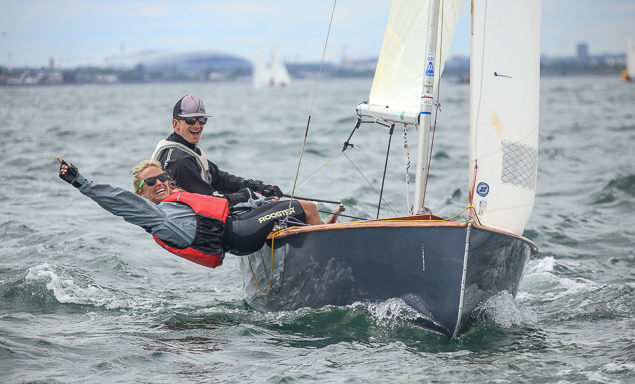 27 GP14s are contesting the class Leinster Championships as part of VDLR 2017
27 GP14s are contesting the class Leinster Championships as part of VDLR 2017
The GP14 Leinster Championships are being lead by Fergus Barnham from Nantwich, UK with Sutton Dinghy Club's Alan Blay in second after six races sailed. Greystones Sailing Club's GP14 World Champion Shane MacCarthy lies third in the 27–boat fleet.
 An immaculate weather spinnaker hoist from Alan Blay
An immaculate weather spinnaker hoist from Alan Blay
 2004 470 Olympians Ross Killian and Ger Owens back together in a GP14 on Dublin Bay
2004 470 Olympians Ross Killian and Ger Owens back together in a GP14 on Dublin Bay
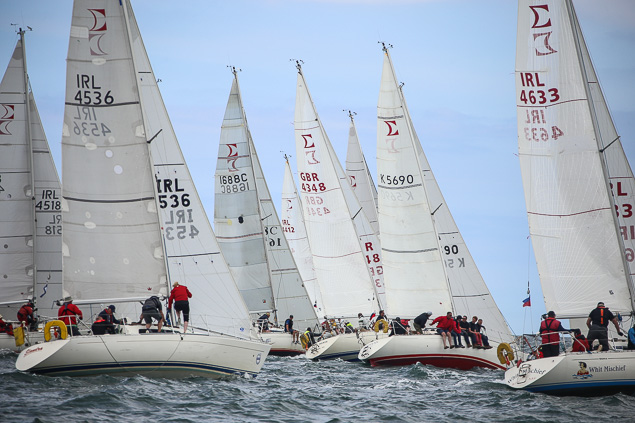 A fine fleet of 20 Sigma 33s are contesting the Irish Class Championships as part of the Regatta
A fine fleet of 20 Sigma 33s are contesting the Irish Class Championships as part of the Regatta
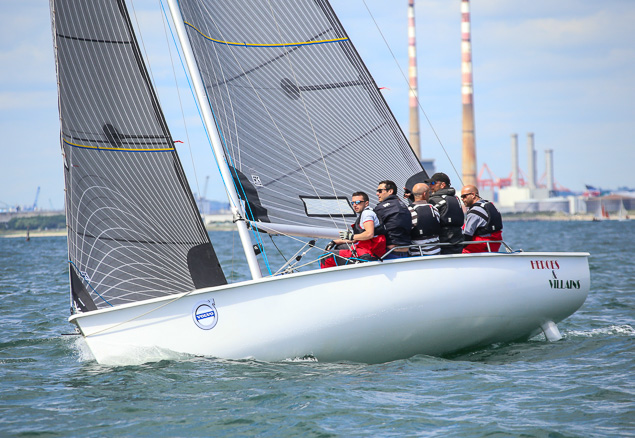 The 1720 Heros and Villans (Gary Rhodes) from Royal Cork Yacht Club is third in the mixed sportsboat class
The 1720 Heros and Villans (Gary Rhodes) from Royal Cork Yacht Club is third in the mixed sportsboat class
Results are provisional and subject to protest.
Full results in all 35 classes are available here
The 2017 regatta concludes tomorrow with two final races for most classes.
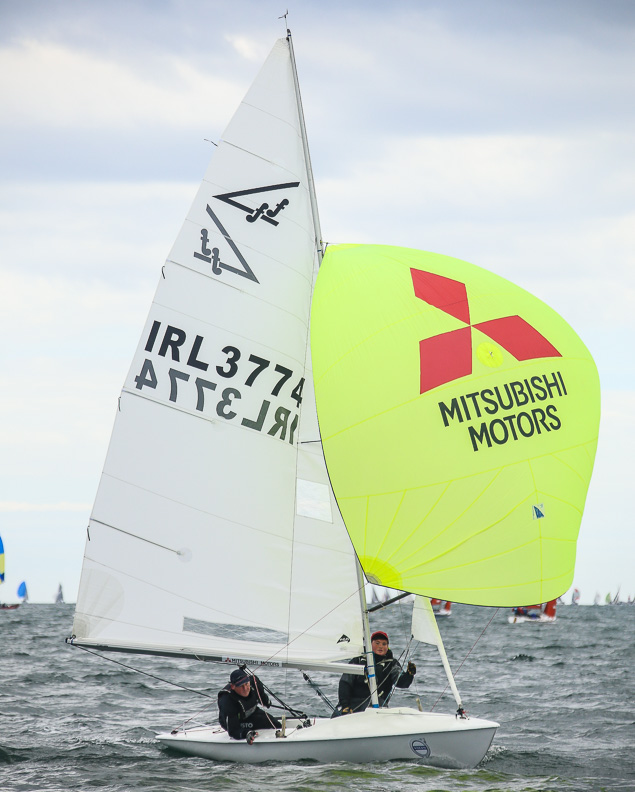 Flying Fifteen (above and below) and Mermaid (bottom) fleets are racing on the Salthill course
Flying Fifteen (above and below) and Mermaid (bottom) fleets are racing on the Salthill course

As Volvo Dun Laoghaire Regatta 2017 reaches its halfway stage, overall leaderboards are shaping up across 35 racing classes. The so far light wind seventh edition of Ireland's biggest sailing event has produced some impressive performances on the water where in some classes leaders are counting straight wins after two days of racing and a full programme so far.
With all classes aiming for either two or three races today, results in the 475–boat fleet were still being computed in some classes at 6pm.
Day two racing started with the bumper 31–boat IRC offshore class and a start close to the Dun Laoghaire shoreline.
The 2015 champion, George Sisk's Farr 42 WOW, made the best of the vagaries of an 18–mile shortened coastal course to win on IRC overall from the Irish National Sailing School (INSS) J109 Jedi skippered by Kenneth Rumball.
The 18–mile course took the fleet south to the Kish Bank but westerly winds proved so fickle for it led to a decision to shorten the race off Bray in County Wicklow.
An hour later, the IRC Zero, One and Two also took the coastal course south for a four and a half hour race.
 There was some good breeze to get offshore and IRC fleets out of the bay......
There was some good breeze to get offshore and IRC fleets out of the bay......
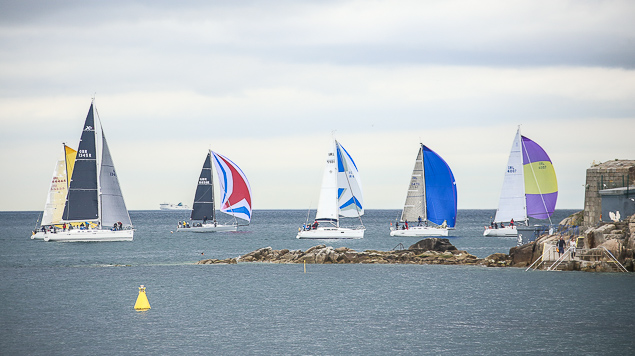 ....hugging the coast by Sandycove Point, spinnakers pulling well.....
....hugging the coast by Sandycove Point, spinnakers pulling well.....
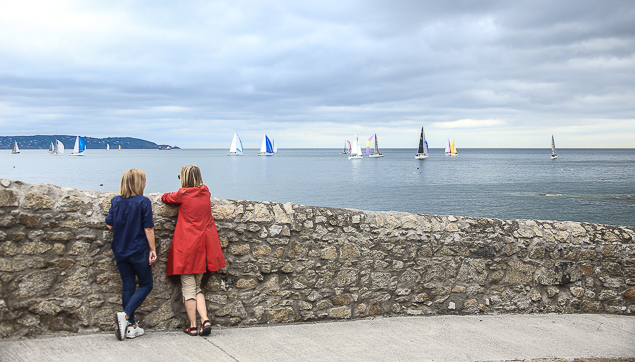 ...but even by Bullock Harbour in Dalkey, problems had started with fickle westerlies for the 18–mile race
...but even by Bullock Harbour in Dalkey, problems had started with fickle westerlies for the 18–mile race
Swansea yacht Dark Angel (Tony Ackland), that has already enjoyed early season success at both June's ICRA Championships at Royal Cork and the Sovereign's Cup in Kinsale, is now leading Class Zero in Dublin. The Dubois 37 has a three point lead over Royal Cork's Ker 37 Jump Juice, (Conor Phelan).
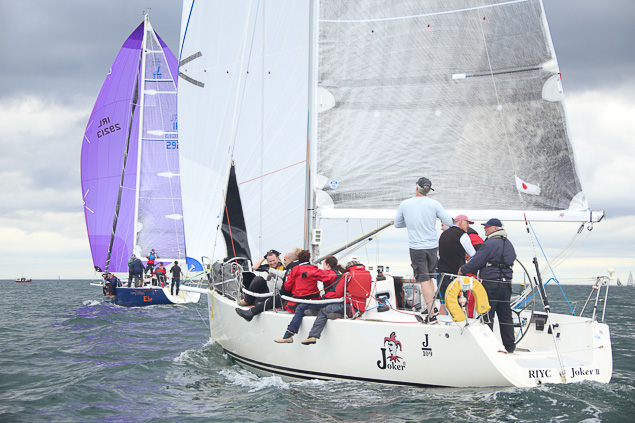 John Maybury managed the light winds well to notch up another counter in today's coastal race to Bray
John Maybury managed the light winds well to notch up another counter in today's coastal race to Bray
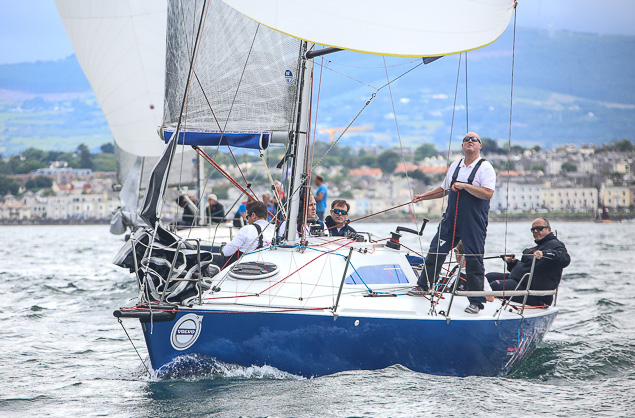 So did Dave Cullen's Checkmate from Howth who has halved the winning margin of the Scottish Class Two leader, Trastada
So did Dave Cullen's Checkmate from Howth who has halved the winning margin of the Scottish Class Two leader, Trastada
An impressive second place for Joker II ensures John Maybury's place at the top of 29–boat IRC one, arguably the most competitive IRC fleet of the regatta. The Royal Irish J109 now leads by 12–points from the visiting Scottish First 36.7 Animal skippered by Kevin Aitken.
In IRC two, Scottish half–tonner Trastada from Fairlie Yacht Club continues to lead but Dave Cullen's Checkmate XV Half Tonner now in second has halved Roddy Angus's lead to just two points.
During the course of the coastal race, the three IRC fleets compressed as they reached the line between the Baily in the north and Dalkey in the south. Half tonners in class two caught up with class one back markers and for many the race restarted as the wait for new wind began. Several observers say prevailing westerlies were fighting with a sea breeze from the east which never materialised.
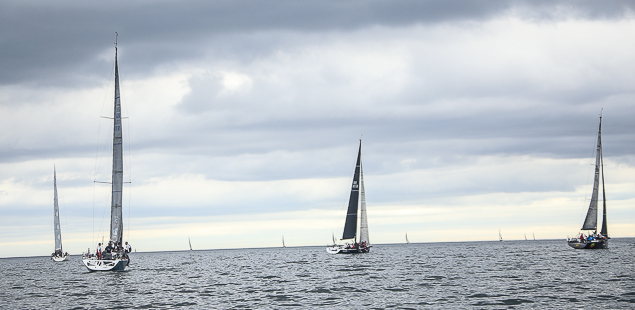 At one point class zero were drifting in no wind....
At one point class zero were drifting in no wind....
 ......while just 300 metres to the north the tightly bunched class one leaders were sailing along in a ten–knot westerly
......while just 300 metres to the north the tightly bunched class one leaders were sailing along in a ten–knot westerly
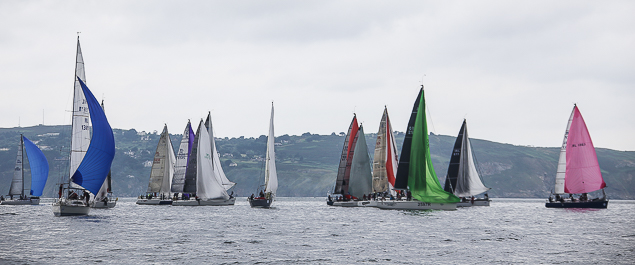 ...but not for long.....
...but not for long.....
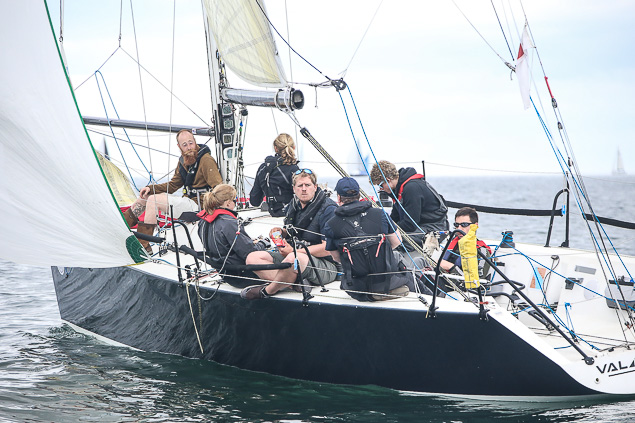 It left only one option. Liverpool Yacht Club entry Valkerie enjoy a Kish Bank picnic
It left only one option. Liverpool Yacht Club entry Valkerie enjoy a Kish Bank picnic
Although the big IRC boats were out in the Irish Sea, the size of the regatta fleet at over 475 boats meant the bay was still full of sails with action across five race courses from 11am. There was also some flat spots for the inshore courses with by far the best conditions off Seapoint Bay for some of the dinghy classes.
In IRC Three, Richard Colwell's Fusion from Howth Yacht Club continued his winning streak with two more wins and a second this time on the centre course to lead by a full eight points in the eight boat fleet.
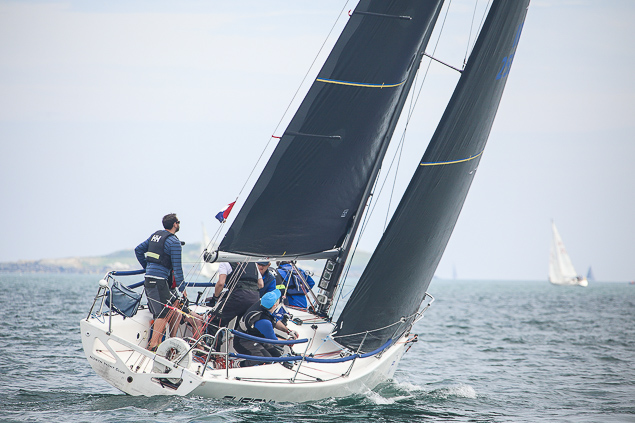 Four wins out of five for Richard Colwell's Corby 33 Fusion
Four wins out of five for Richard Colwell's Corby 33 Fusion
In IRC four, Ken Lawless's Quarter Tonner also keeps his early lead but only by half a point. Cartoon, on 8.5 points, leads Jonathan Flood's modified Formula 28 Flash from Bray Sailing Club in the 15-boat fleet.
Many of Afloat.ie's IRC predictions are ringing true but there's still a long way to go before the fatlady sings at Dun Laoghaire on Sunday.
Ten classes have included the regatta as part of their championship calendar in 2017: GP14s, 420s and Mermaid dinghies are racing for Leinster honours, while SB20s, J24s and Squibs will decide East Coast titles, and the Sigma 33s, Beneteau 21s and the Wayfarers will race for national trophies.
420 National Champions Geoff Power and James McCann from Waterford harbour who were crowned last week at Royal Cork's DinghyFest are on target for the Leisnter title too with three second places to give them a two point margin in the 14–boat fleet.
 420 dinghies training in Dun Laoghaire Harbour prior to today's Leinster Championships
420 dinghies training in Dun Laoghaire Harbour prior to today's Leinster Championships
In the 20–boat Sigma 33 Irish championships, UK visitors occupy the top three places after four races sailed. Dan Lewis's Neyland Yacht Club entry Partisan leads but is on the same four points as the Clyde's Alan Harper. Third is Toby Claridge's Excelle. The top Irish boat is Ballyholme's Paul Prentice in sixth place.
Gerry Dowling's Bad has a string of four wins from five races in the 18–boat SB20 sportsboat championships. Second is Michael O'Connor's Sin Bin, six points adrift.
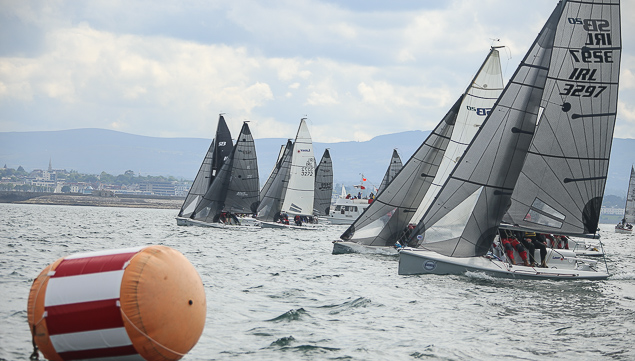 David Dwyer's Sunday Brunch (3297), from the Royal St. George YC, takes the pin in an SB20 start
David Dwyer's Sunday Brunch (3297), from the Royal St. George YC, takes the pin in an SB20 start
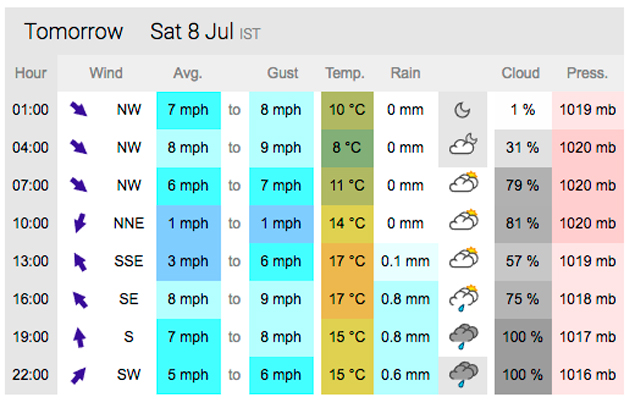 XC weather predicts lighter conditions for Saturday
XC weather predicts lighter conditions for Saturday
According to forecasters, it looks like there will be more light westerlies for racing tomorrow and as a result organisers plan for a start one hour later than scheduled.
Meanwhile, yesterday's first race of the offshore class was put into turmoil right at the end of the race. The VDLR Protest Committee found there was an 'improper action' of the Race committee in writing 'ambiguous sailing instructions' and not signalling correctly the course to be sailed, which created confusion in the finish of yesterday's offshore fleet finish at the harbour.
It directly affected the finishing positions of a majority of the fleet. The misunderstanding of the sailing instructions and course signal was not the fault of the competitors, the jury found. It granted redress so boats were to be scored by the list of times by the GPS tracking company that tracks the offshore fleet.
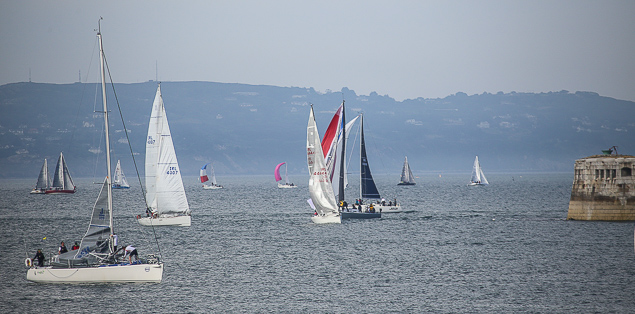 There was finish line confusion (above) and then redress for the offshore fleet yesterday after a protest hearing
There was finish line confusion (above) and then redress for the offshore fleet yesterday after a protest hearing
Results are provisional and subject to protest Full results in all 35 classes are available here.




























